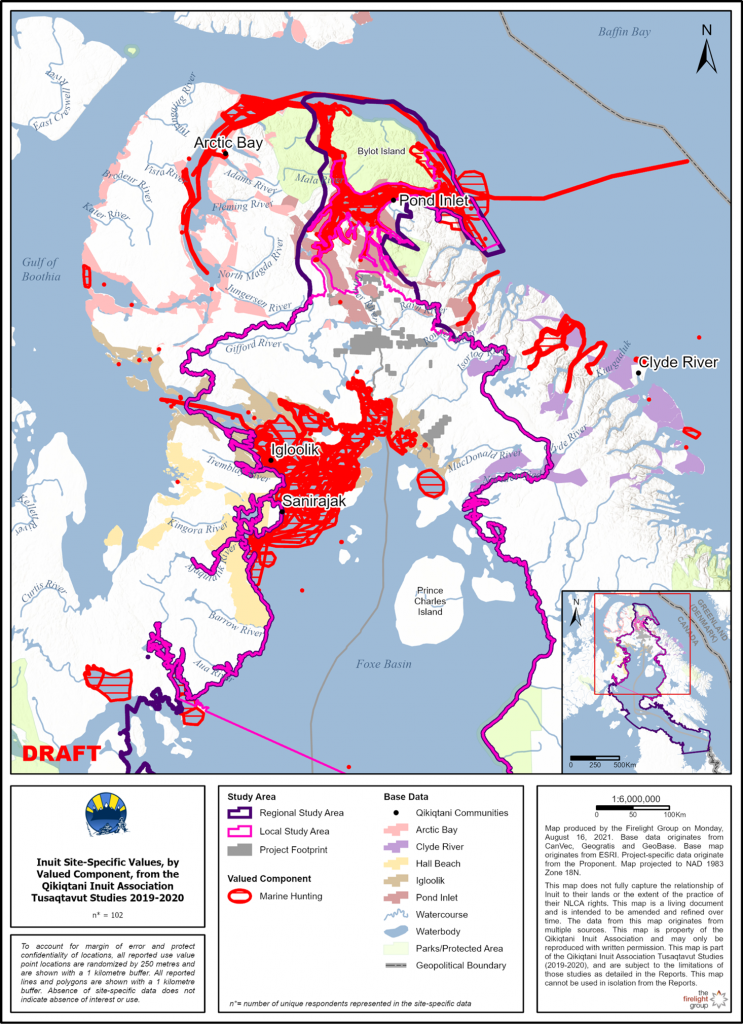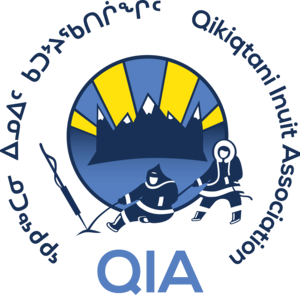Community members hunt and harvest many different kinds of marine animals, including various kinds of seal (such as ringed, bearded, and harp), narwhal and beluga and bowhead whales, and polar bear. Community members showed us important habitat for these animals, including migration routes, and calving and feeding areas, as well as places important for hunting and processing animals, such as camps and cache sites.
We heard from community members how hunting marine animals is central to the Inuit way of life. Species like walrus, various seals, narwhal, belugas, and other whales are important sources of food. Hunting happens all year-round and provides not only food, but the raw materials for making clothing, tools, and for other uses.
I’ll probably keep hunting until I die around this area. So – plus my kids, they learn they know I hunt all year around, I catch about 150 seals per year, just to give out meat for the hungry people and the elders. (I22, 29-May-19)
Community members told us that to be able to hunt marine animals successfully, and knowing how to use the animals fully, requires a lot of special knowledge and experience. This includes knowing where and when to go hunting, about animal behaviours, and special hunting skills (like how to kill a walrus without losing it in the water). A lot of this knowledge is passed on from teacher to student, generation to generation. Inuit often begin hunting at a young age, and marine hunting skills are passed down through families while people are out on the land.
I think nowadays it’s just maybe mostly important to the old hunters or to the elders, because those are people who can now eat only the meat. Most young people can still eat it too, but only mostly the hunters go to hunt seals now too. But in spring and summer a lot of people go out. Mostly more people start going out … Hunting in the warmer weather, better temperature to hunt. (P23, 28-Apr-19)
Inuit who participated in interviews shared some of their favourite hunting places and places where there is an abundance of animals (like Ikpikitturjuaq and Steensby Inlet, among others), as well as places that are important habitat or migration routes (e.g., Foxe Basin for whales). However, some people also told us that certain species are being seen in fewer numbers than in the past.
Like many other activities on the land and water, hunting marine animals is a social activity. Whether hunting for whales, seal, or walrus, people are often out on the land and sea with family and friends. We also heard that sharing the food from a successful hunt is an important protocol for many Inuit.
That [Bowhead whale] was the most satisfying hunt he’s ever had in his entire life … Because it was such a huge animal … Yeah, the whole community – harvested. And they even exported some … Yeah. Yeah, that’s a whole part of the hunting party, is to pass on the skills to the younger generation. (A04, 03 November 2020, interpreted)
Important Areas for Marine Harvesting
For the Pond Inlet community, marine hunting values are found in the Eclipse Sound region between Bylot Island and northern Baffin Island. Particular concentrations of values also recored in Tremblay Sound, Qinngua and at the floe edge by Button Point. A concentration of narwhal habitat was identified in Tremblay Sound and Qinngua, including in the vicinity of Bruce Head.
Community members from Arctic Bay and Clyde River hunt both north and south of the Mary River Project area, including Milne Inlet, Eclipse Sound, Navy Board Inlet, Pond Inlet, Baffin Bay, Bylot Island area, the North Baffin coastline, and Steensby Inlet.
Iglulik and Sanirajak community members identified marine hunting values throughout Foxe Basin, including in Ikpikitturjuaq of northern Foxe Basin, as well as along the Melville Peninsula, around Rowley Island, near the communities of Igloolik and Sanirajak, and along the western shores of Baffin Island.

Possible Impacts from the Mary River Project on Marine Harvesting
When we asked Inuit about the Mary River Project and how it might affect their ability to hunt marine animals, community members said they were worried about animals would be bothered by noises (from ships and trains) and human activity. Community members also expect that animals would change their behaviour on the land and sea (e.g., walrus becoming more aggressive, migration routes and calving areas disrupted, etc.) because of the Mary River Project’s activities.
Marine wildlife do not like noise and the accounts coming from the people in Pond Inlet is because of the noise from the ship that the marine [wildlife] just dispersed themselves, because they like to be in an area where it’s less noise and less disturbance. Because they’re very sensitive animals. (C15 2020a, interpreted from Inuktitut)
Inuit are worried that marine animal habitats would be lost because of the Mary River Project. Sea ice, which is important for walruses for example, could melt more quickly if broken up by ships. And, at the same time, animals could be affected by pollution, like dust or fuel spills, which could contaminate the water, ice, shellfish, and marine animals.
…because due to more increased shipping I’ve seen less and less narwhal each year … Previous couple years there was a guy who counted narwhals. He said there was around 12,000 narwhals. And this year, there was a couple hundred … So, nobody was stocking up for the winter. Yeah. Everybody wanted muktuq. You go out narwhal hunting, you catch a narwhal, then you want to ferment some for winter, but you can’t because it’s there wasn’t enough to ferment and bring home. (P09, 05-Feb-19)
She is concerned about the increase shipping will have a huge impact on the marine wildlife and she feels that they’re all going to … disperse and go to different places, they’ll try to go there, but because of the noise of the constant ships route going back and forth, they can try to go back, but if they’re too disturbed by it, they would go somewhere else … (A10 2020, interpreted from Inuktitut)
Because of the Mary River Project, community members expect there to be fewer animals like walrus, seals, polar bears, and whales in places where they hunt (e.g., Qinngua area). We heard that this would mean fewer opportunities to pass on hunting knowledge, and impacts to food security more generally.

